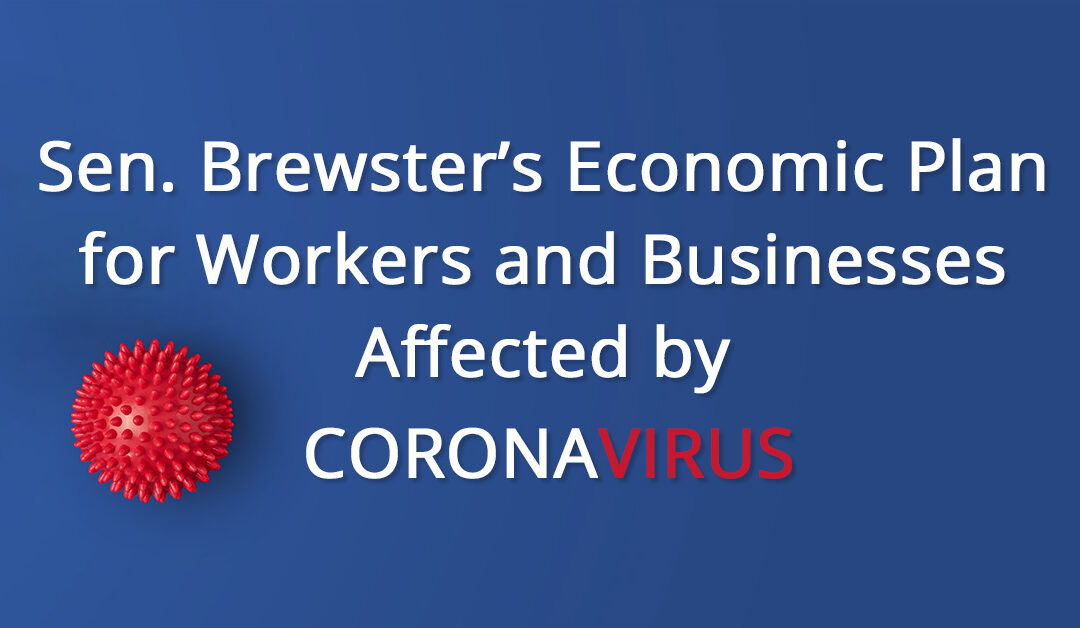
December 23, 2020
McKeesport – December 23, 2020 – Senator Jim Brewster today announced more than $6 million in state grants that will go to projects in the 45th senatorial district.
“I was happy to advocate for these important projects, and I am excited to see them come to fruition thanks to this investment from the state,” said Senator Brewster. “Each of the projects funded today will bolster our region’s economy.”
The funding comes from the Redevelopment Assistance Capital Program (RACP), a Commonwealth grant program administered by the Office of the Budget for the acquisition and construction of regional economic, cultural, civic, recreational, and historical improvement projects.
One of the projects funded will be the expansion of PurePenn in McKeesport. The medical marijuana manufacturer will receive $2,000,000 to conduct an interior build-out which will include mechanical, electrical, fire protection, and other interior building components.
“This investment in McKeesport has been a job creator and a real contributor to the regional economy”, said Brewster. “I am looking forward to what comes for the area from this substantial funding.”
Also, UPMC St. Margaret’s Family Health Center in New Kensington will receive $1,250,000 for a new clinical space to accommodate more patients, provide room for team and group meetings, and offer swing spaces for outside social service agencies.
The Greater Pittsburgh Community Food Bank will receive $1,000,000 to improve overall efficiency and support distribution of more fresh produce.
In addition to these investments, the Braddock Carnegie Library Association is slated to receive $1,000,000 to implement the first comprehensive building renovation and preservation plan in the 132-year history of the Braddock Carnegie Library.
And finally, the Former Westinghouse HQ/Pittsburgh Supercomputing Center in Monroeville will receive $1,000,000 as it moves forward with efforts to provide university, government and industrial researchers with access to systems for high-performance computing, communications, and data storage.

March 23, 2020
Senator says state needs to fill gaps in federal aid
McKeesport – March 23, 2020 – As efforts to curb the spread of COVID-19 continues and federal economic plans come into view, a state stimulus effort focused on workers and small business is critical to fill gaps in national recovery efforts, state Sen. Jim Brewster (D-Allegheny/Westmoreland) said today.
In a detailed letter to Gov. Tom Wolf, Brewster laid out a 6-point plan to bolster economic recovery efforts and speed help to workers and small businesses once health risks subside.
“The federal government is capable of marshalling resources to deliver short-term economic relief for those impacted by the pandemic; and Congress is moving toward adopting a robust plan to kick-start the economy once the COVID-19 threat is contained,” Brewster said. “Without question, there will be gaps in the federal effort and that is where the state has a role to play.
“Infusing cash into the economy through grants to small business, bolstering unemployment compensation, accelerating public works projects, reducing business tax liability over the long-term, expanding bonding capacity and coordinating the response through a one-stop response office are ways the state can step in and speed relief.”
Brewster said his 6-point plan would buttress an expected a massive federal relief package now winding its way through Congress.
Details of the plan include:
- Unemployment Compensation (UC) Booster: To help workers weather the economic crisis, a state-augmented booster in the form of direct payments to workers who lost their jobs in the pandemic should be an integral part of the economic recovery plan. The UC booster would augment and supplement evolving federal efforts to help the unemployed.
- Bridge Grants: Create short-term bridge grants to get business up and running as soon as possible and cover near-term expenses. Once the immediate financial crisis period is over, provide additional assistance to qualifying small business can be in the form of zero-interest or very low-interest loans. The three-step approach would give businesses breathing room and provide a foundation for recovery.
- Expand Bonding Capacity: The funding to small businesses would come from expanding or repurposing Pennsylvania’s bonding capacity with new financing through either the Commonwealth Financing Authority or other bonding authority with funds immediately available for grants. Plus, sweep unencumbered General Fund and special fund accounts to finance recovery efforts.
- Special Tax Provisions: Expand Net Loss Carryforward: Help small businesses deal with long- term impacts, expand net loss carryforward program to cover taxes and help reduce future pandemic-related tax liabilities.
- Accelerate Infrastructure Improvement Projects: Pushing state funds out now and opening financial levers to fund water, sewer, transportation and community improvement projects would not only generate work directly in construction but also require supply chains to ramp up hiring to fill commodity requirements.
- Pandemic Recovery Czar: Coordinate the response and the distribution of funding specifically related to the pandemic through a single contact point in state government — a “recovery czar.” A recovery czar was effectively utilized by the federal government during the financial crisis a decade ago and has been a successful model for coordination of government services during past crises.
“My goal in detailing the plan is to begin identifying state resources and capabilities so that we can immediately respond to the economic crisis caused by the pandemic,” Brewster said.
The senator said he expects his Senate colleagues, House legislators and the governor to have other ideas about how to address the economic crisis. He said detailing his plan would help promote discussions of a robust state effort to reinforce federal stimulus plans.
-30-
Editor’s note: Sen. Brewster’s letter to Gov. Tom Wolf follows.
March 23, 2020
Honorable Tom Wolf, Governor
Commonwealth of Pennsylvania
225 Main Capitol
Harrisburg, PA 17025
Dear Governor Wolf:
The impact of the COVID-19 pandemic has had life-altering implications for citizens across Pennsylvania, throughout the United States and around the world. The steps your administration has taken to protect the health, safety and security of Pennsylvanians will save lives and stop the spread of the disease. Addressing the health care crisis is the priority now.
Pennsylvanians have heeded the call, and most are practicing social distancing. In addition, swaths of businesses have now been temporarily closed to aid mitigation efforts. Once the imminent health threat is addressed and Pennsylvanians are permitted to return to work and resume their lives, we need to look at the next steps that can be taken to restart economic activity as quickly as possible.
Economic experts generally agree that the way for our nation and state to bounce back quickly is by infusing cash back into the economy. I wholeheartedly endorse any effort to get dollars into hands of workers, small businesses and all consumers. This is the best way to jump-start our economic recovery from the pandemic.
While Pennsylvania does not have the financial capacity of the federal government to present massive aid, we can provide substantial gap funding and augment national recovery efforts. The state’s effort needs to be broad-based and focused on workers, families and small business. We must be creative and willing to explore innovations to existing programs while being flexible so that economic needs can be met.
Our current unemployment compensation (UC) program will provide a brief, but insufficient respite for workers. While UC will help and the now-evolving federal stimulus efforts will likely bolster our UC program, it will not be enough to provide long-term family-sustaining compensation.
Extreme pressure will be placed on the system from the tens of thousands of displaced workers. Given the strain on the system, we must explore additional ideas to respond to needs of working men and women. To that end, we should plan on providing a state-funded booster, or UC kicker to the federal effort. Adding a state booster –perhaps $100 to $200 per month for pandemic-related job loss — would help workers get some relief now.
Another critical way to help workers — once the health risk abates– is through a robust assistance package for small businesses and those essential consumer businesses that have remained at work but have lost huge amounts of revenue during the shut-down. This includes dine-in restaurants that have become drive-thru services, media companies reliant on advertising from forced-closed business establishments and others that have remained open yet have absorbed losses from the pandemic. We cannot forget them in the recovery.
Lastly, we can put people back to work directly, and quickly, if we accelerate state grants and loans for infrastructure improvements and push out state money for water and sewer grants and loans, transportation projects and community improvements that are currently in the pipeline. Not only will this create jobs in construction, it will require supply chains to ramp up production and hire workers to fill needs.
This broad expansion would be funded in the near term by an aggressive expansion of bonding and use of all state financial levers to open doors to capital markets. In addition, we need to sweep unused and unencumbered state dollars in the General Fund and special accounts to speed the infusion of money and boost immediate recovery.
In an outline below, I’ve identified several elements of a state-based plan that would augment the federal assistance package that is now being crafted. These thoughts could be combined with other proposals you and your staff are gathering as we manage the recovery from the COVID-19 pandemic.
The plan includes:
- Unemployment Compensation (UC) Booster: To help workers weather the economic crisis, a state-augmented booster in the form of direct payments to workers who lost their jobs in the pandemic should be an integral part of the economic recovery plan. The UC booster would augment and supplement now-evolving federal efforts to help the unemployed.
- Bridge Grants: We need to provide short-term bridge grants to get business up and running as soon as possible and cover near-term expenses. Then, once the immediate financial crisis period is over, further assistance to qualifying small business can be in the form of zero-interest or very low-interest loans. This 3-step approach would give businesses breathing room and provide a foundation for recovery.
- Expand Bonding Capacity: The funding provided to small business should come from an expansion of our bonding capacity with new financing provided through either the Commonwealth Financing Authority or other bonding authority with funds immediately available for grants. Plus, we should transfer unencumbered General Fund and special fund accounts to finance recovery efforts.
- Special Tax Provisions: Expand Net Loss Carryforward: To help small businesses deal with long term impacts, we should expand the net loss carryforward program to cover taxes and help reduce future pandemic-related tax liabilities. Keeping business in business will spur re-hiring and be an important feature of our recovery.
- Accelerate Infrastructure Improvement Projects: Pushing state funds out now and opening financial levers to fund water, sewer, transportation and community improvement projects would not only generate work directly in construction but also require supply chains to ramp up hiring to fill commodity requirements.
- Business Recovery Czar: We should coordinate the response and the distribution of funding specifically related to the pandemic through a single contact point in state government — a “business recovery czar.” A recovery czar was effectively utilized by the federal government during the financial crisis a decade ago and has been a successful model for coordination of government services during past crises.
I realize that there will be many concepts and proposals offered to address economic needs of workers and businesses. The items noted in this letter represent one way to address the needs of working men and women and small business.
Please contact me if you or your staff are interested in further discussion.
Sincerely,
Jim Brewster
State Senator

January 18, 2019
Harrisburg, Jan. 17, 2019 – Education grants dedicated to the implementation and improvement of computer science programs and career-readiness have been awarded to schools in Allegheny and Westmoreland counties, said Sen. Jim Brewster (D-Allegheny/Westmoreland).
“As computer technology continues to evolve, it is important that students can experience and learn new computer skills first hand,” Brewster said. “I am pleased that students in our area will benefit from Pennsylvania’s grants dedicated to improving computer science programs in local schools.”
Baldwin-Whitehall, Duquesne, East Allegheny and South Allegheny in Allegheny County, along with Burrell and Kiski school districts in Westmoreland, were approved for funding through the PAsmart initiative. The grants are for $35,000 each.
PAsmart grants are used to fund high-quality STEM and computer science courses for K-12 students, specifically those in low-income areas where access to up-to-date STEM technology may be limited.
Brewster noted that the state’s commitment to funding innovative technology and STEM education for Pennsylvania students has resulted in the state ranking second in the country for STEM education funding.
“PAsmart grants are an excellent investment in the future of our students,” Brewster said. “We must continue to provide for educational programs and opportunities that will prepare students to enter the ever-changing, fast paced workforce.”
A total of $8.7 million were distributed to 221 school districts for 765 individual schools.
-30-



